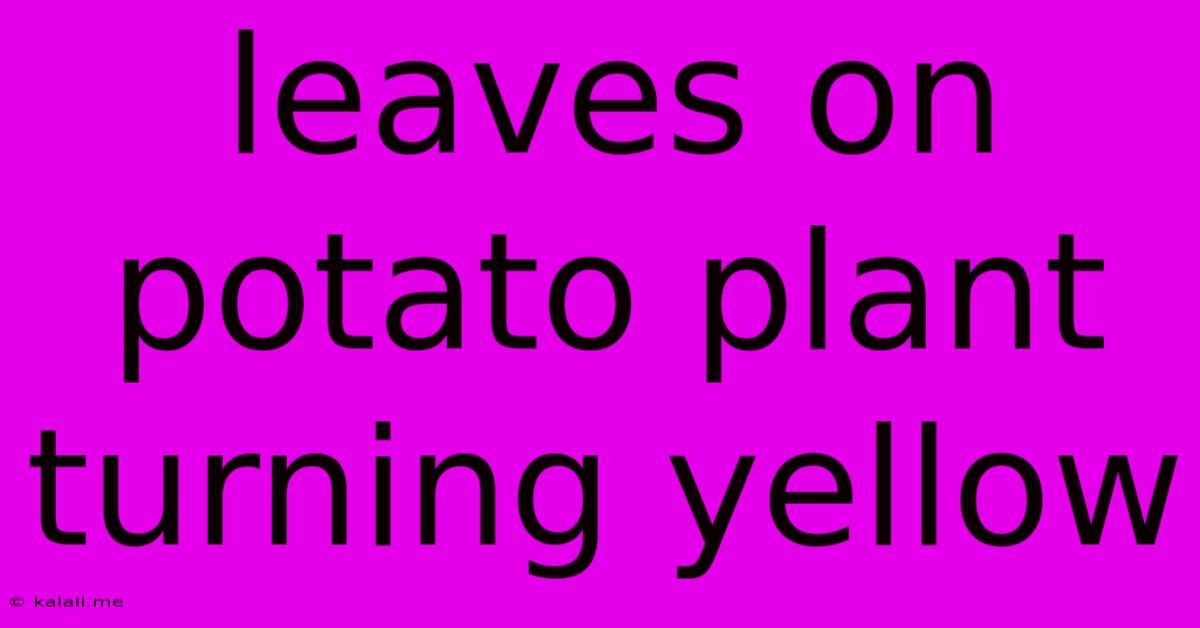Leaves On Potato Plant Turning Yellow
Kalali
May 22, 2025 · 3 min read

Table of Contents
Why Are My Potato Plant Leaves Turning Yellow? A Comprehensive Guide
Seeing yellowing leaves on your potato plants can be alarming, but understanding the causes can help you take corrective action and save your crop. This guide explores the common reasons behind yellowing potato leaves, offering practical solutions to restore your plants to their vibrant green state. From nutrient deficiencies to pests and diseases, we'll cover it all.
Yellowing potato leaves can be caused by a variety of factors, including nutrient deficiencies, pests, diseases, and environmental stress. Early identification and appropriate treatment are crucial for a healthy potato harvest.
Nutrient Deficiencies: The Hungry Potato Plant
One of the most frequent causes of yellowing leaves is a lack of essential nutrients. Potatoes are heavy feeders, requiring ample nutrients for vigorous growth and tuber development.
-
Nitrogen Deficiency: This is a common culprit. Nitrogen is vital for chlorophyll production, the pigment responsible for the green color of leaves. A nitrogen deficiency manifests as a general yellowing, often starting with the older, lower leaves. The leaves may also appear pale and stunted. Solution: Apply a nitrogen-rich fertilizer according to package instructions. Organic options include compost tea or manure.
-
Potassium Deficiency: Potassium is crucial for overall plant health and disease resistance. A potassium deficiency often presents as yellowing or browning of the leaf margins, progressing inward. Solution: Apply a potassium-rich fertilizer, following the instructions carefully. Banana peels, rich in potassium, can be added to the soil as a natural remedy.
-
Magnesium Deficiency: Magnesium is a key component of chlorophyll. A deficiency leads to yellowing between the leaf veins, while the veins themselves remain green (interveinal chlorosis). Solution: Apply a magnesium-containing fertilizer, or use Epsom salts (magnesium sulfate) as a soil amendment.
Pests and Diseases: Unseen Enemies
Pests and diseases can also significantly impact the health of your potato plants, resulting in yellowing leaves.
-
Potato Leafhoppers: These tiny insects suck sap from the leaves, causing yellowing and stippling. Severe infestations can lead to leaf curling and stunted growth. Solution: Monitor your plants regularly. Natural predators like ladybugs can help control leafhopper populations. Insecticidal soap can be used as a targeted treatment.
-
Potato Virus Y (PVY): This virus is transmitted by aphids and causes a range of symptoms, including leaf yellowing, leaf curling, and stunted growth. Unfortunately, there's no cure for PVY. Solution: Preventative measures are crucial. Plant disease-resistant varieties, control aphid populations, and remove infected plants immediately.
-
Verticillium Wilt: This fungal disease attacks the vascular system of the potato plant, disrupting nutrient and water transport. Symptoms include yellowing and wilting of leaves, often starting on one side of the plant. Solution: Practice crop rotation, use disease-free seed potatoes, and consider soil solarization to eliminate the fungus.
Environmental Stress: External Factors
Environmental conditions can also contribute to yellowing leaves:
-
Water Stress: Both underwatering and overwatering can lead to yellowing leaves. Underwatered plants show wilting and yellowing, particularly in older leaves. Overwatering can lead to root rot, which also manifests as yellowing and wilting. Solution: Maintain consistent soil moisture, ensuring good drainage.
-
Sunlight: Insufficient sunlight can cause pale, yellow leaves. Conversely, excessive sunlight can scorch leaves, leading to yellowing and browning. Solution: Choose a planting location with adequate sunlight, but protect plants from intense afternoon sun if necessary.
Diagnosing the Problem: A Step-by-Step Approach
To effectively address yellowing leaves, you need to identify the underlying cause. Carefully examine your plants, noting the pattern of yellowing, the presence of pests or diseases, and any other unusual symptoms. Consult local agricultural extension services or online resources for further assistance with diagnosis.
By understanding the various factors that cause yellowing leaves on potato plants and implementing appropriate solutions, you can improve the health and yield of your potato crop, ensuring a bountiful harvest. Remember, proactive monitoring and preventative measures are key to maintaining healthy potato plants.
Latest Posts
Latest Posts
-
Fix Hairline Crack In Porcelain Sink
May 22, 2025
-
Delete Non Empty Directory In Linux
May 22, 2025
-
Sim Card To Sim Card Transfer
May 22, 2025
-
Sony A Mount Lens To E Mount
May 22, 2025
-
How Do I Remove Tar From Clothes
May 22, 2025
Related Post
Thank you for visiting our website which covers about Leaves On Potato Plant Turning Yellow . We hope the information provided has been useful to you. Feel free to contact us if you have any questions or need further assistance. See you next time and don't miss to bookmark.